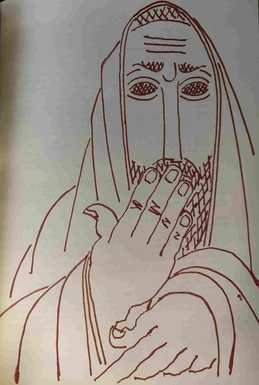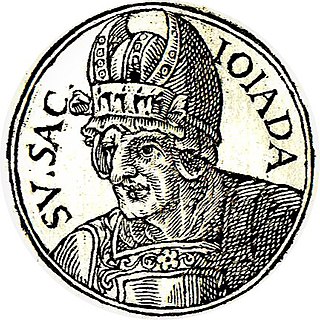Related Research Articles
Annas was appointed by the Roman legate Quirinius as the first High Priest of the newly formed Roman province of Judaea in AD 6 – just after the Romans had deposed Archelaus, Ethnarch of Judaea, thereby putting Judaea directly under Roman rule.
Yeshua was a common alternative form of the name Yehoshua in later books of the Hebrew Bible and among Jews of the Second Temple period. The name corresponds to the Greek spelling Iesous (Ἰησοῦς), from which, through the Latin IESVS/Iesus, comes the English spelling Jesus.

Tevet is the fourth month of the civil year and the tenth month of the ecclesiastical year on the Hebrew calendar. It follows Kislev and precedes Shevat. It is a month of 29 days. Tevet usually occurs in December–January on the Gregorian calendar. In the Babylonian calendar its name was Araḫ Ṭebētum, the "muddy month".

Josef Ben Caiaphas, known simply as Caiaphas in the New Testament, was the Jewish high priest during the years of Jesus' ministry, according to Josephus. The Gospels of Matthew, Luke and John indicate he was an organizer of the plot to kill Jesus. He famously presided over the Sanhedrin trial of Jesus. The primary sources for Caiaphas' life are the New Testament, and the writings of Josephus. The latter records he was made high priest by the Roman procurator Valerius Gratus after Simon ben Camithus had been deposed.

Eli was, according to the Book of Samuel, a priest and a judge of the Israelites in the city of Shiloh, ancient Israel. When Hannah came to Shiloh to pray for a son, Eli initially accused her of drunkenness, but when she protested her innocence, Eli wished her well. Hannah's eventual child, Samuel, was raised by Eli in the tabernacle. When Eli failed to rein in the abusive behavior of his own sons, God promised to punish his family, which resulted in the death of Eli's sons at the Battle of Aphek where the Ark of the Covenant was also captured. When Eli heard the news of the captured Ark, he fell from his seat, broke his neck, and died. Later biblical passages mention the fortunes of several of Eli's descendants.

Eleazar or Elazar was a priest in the Hebrew Bible, the second High Priest, succeeding his father Aaron after he died. He was a nephew of Moses.
Yohananיוֹחָנָן, sometimes transcribed as Johanan is Hebrew male given name that can also appear in the longer form of יְהוֹחָנָן, meaning "YHWH is gracious".

The Seleucid era ("SE") or Anno Graecorum, sometimes denoted "AG," was a system of numbering years in use by the Seleucid Empire and other countries among the ancient Hellenistic civilizations, and later by the Parthians. It is sometimes referred to as "the dominion of the Seleucidæ," or the Year of Alexander. The era dates from Seleucus I Nicator's reconquest of Babylon in 312/11 BC after his exile in Ptolemaic Egypt, considered by Seleucus and his court to mark the founding of the Seleucid Empire. According to Jewish tradition, it was during the sixth year of Alexander the Great's reign that they began to make use of this counting. The introduction of the new era is mentioned in one of the Babylonian Chronicles, The Chronicle of the Diadochi.

Simeon ben Gamliel (I) (Hebrew: שמעון בן גמליאל or רשב"ג הראשון; c. 10 BC – 70 AD) was a Tanna sage and leader of the Jewish people. He served as nasi of the Great Sanhedrin at Jerusalem during the outbreak of the First Jewish–Roman War, succeeding his father in the same office after his father's death in 50 AD and just before the destruction of the Second Temple.
Joshua ben Gamla, also called Jesus the son of Gamala, was a Jewish high priest in about 64-65 CE. He was killed during the First Jewish–Roman War. While the Talmud refers to Joshua ben Gamla, the earlier Greek works of Josephus Flavius call him Γαμάλα μὲν υἱὸς Ἰησοῦς a semitism for: The son of Gamala, Jesus.
Joshua ben Perahiah or Joshua ben Perachya was Nasi of the Sanhedrin in the latter half of the 2nd century BC.

Jehoiada in the Hebrew Bible, was a prominent priest in the kingdom of Judah during the reigns of Ahaziah, Athaliah, and Joash. Jehoiada became the brother-in-law of King Ahaziah as a result of his marriage with princess Jehosheba. Both Jehosheba and Ahaziah were children of King Jehoram of Judah. Ahaziah died a year after assuming the throne, which was then usurped by his mother Athaliah, who ordered the execution of all members of the royal family.

Onias II was the son of Simon I. He was still a minor when his father died, so his uncle Eleazar, and whom after, the latter's uncle Manasseh, officiated as high priests before Onais himself succeeded to that dignity. According to Josephus, he was a covetous man and of limited intelligence, whose refusal to pay the twenty talents of silver which every high priest was required to pay to Ptolemy III Euergetes, the King of Egypt threatened to imperil both the high priest and the people. The impending disaster was averted by Onias’ nephew Joseph, son of Tobias, who, having friendly relations with the Egypt court, managed to conciliate Ptolemy. Onias is said to have died, almost simultaneously with his nephew Joseph, during the reign of Seleucus IV Philopator, hence about 181 BC. His son, Simon II assumed the high priestly office after the demise of his father.
Sanballat the Horonite – or Sanballat I – was a Samaritan leader, official of the Achaemenid Empire, and contemporary of the Israelite prophet Nehemiah who lived in the mid-to-late 5th century BC. He and his family are mentioned in the contemporary Elephantine papyri and ostraca.

Joshua is a given name derived from the Hebrew יְהוֹשֻׁעַ, prominently belonging to Joshua, an early Hebrew leader of the Exodus period who has a major role in several books of the Bible. The name was a common alternative form of the name יֵשׁוּעַ (Yēšūaʿ) which corresponds to the Greek spelling Ἰησοῦς (Iesous), from which, through the Latin Iesus, comes the English spelling Jesus. As a result of the origin of the name, a majority of people before the 17th century who have this name were Jewish. A variant, truncated form of the name, Josh, gained popularity in the United States in the 1920s.
Ananelus was a Jewish High priest in the 1st century BCE.
Ananias son of Nedebeus was a high priest who, according to the Acts of the Apostles, presided during the trials of the apostle Paul at Jerusalem and Caesarea.
Ishmael ben Fabus also known as Ishmael ben Phiabi and Ishmael ben Phabi was a High Priest of Israel in the 1st century CE. He was High Priest of Israel from 15 CE to 16 CE under the Roman procurator, Valerius Gratus, and is thought to be the same High Priest who was reinstated by Agrippa in 58 CE to 62 CE.
References
- ↑ James C. Vander Kam, From Joshua to Caiaphas: High Priest after the Exile (Fortress, 2004).
- ↑ Robert Killian The Holy Bible "Chronicle" of Sequential Biblical Events (AuthorHouse, 2012).
- ↑ JewishEncyclopedia.
- ↑ High Priests of the Second Temple Period.
- ↑ Flavius Josephus, Antiquities 17.13.1.